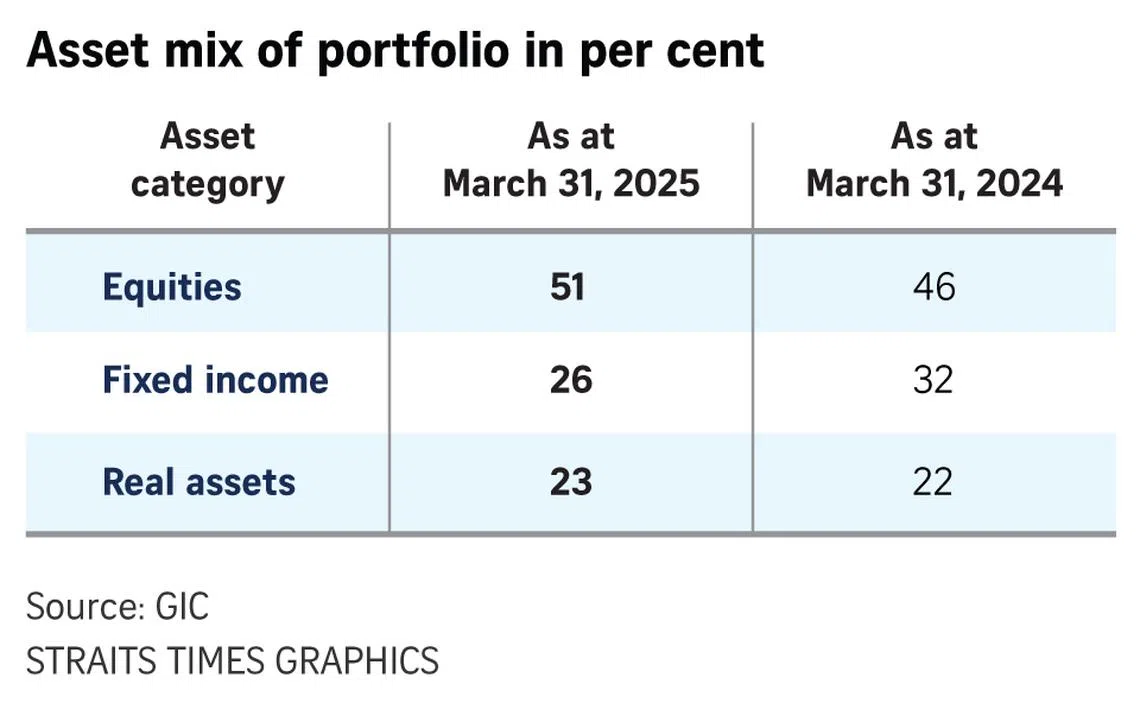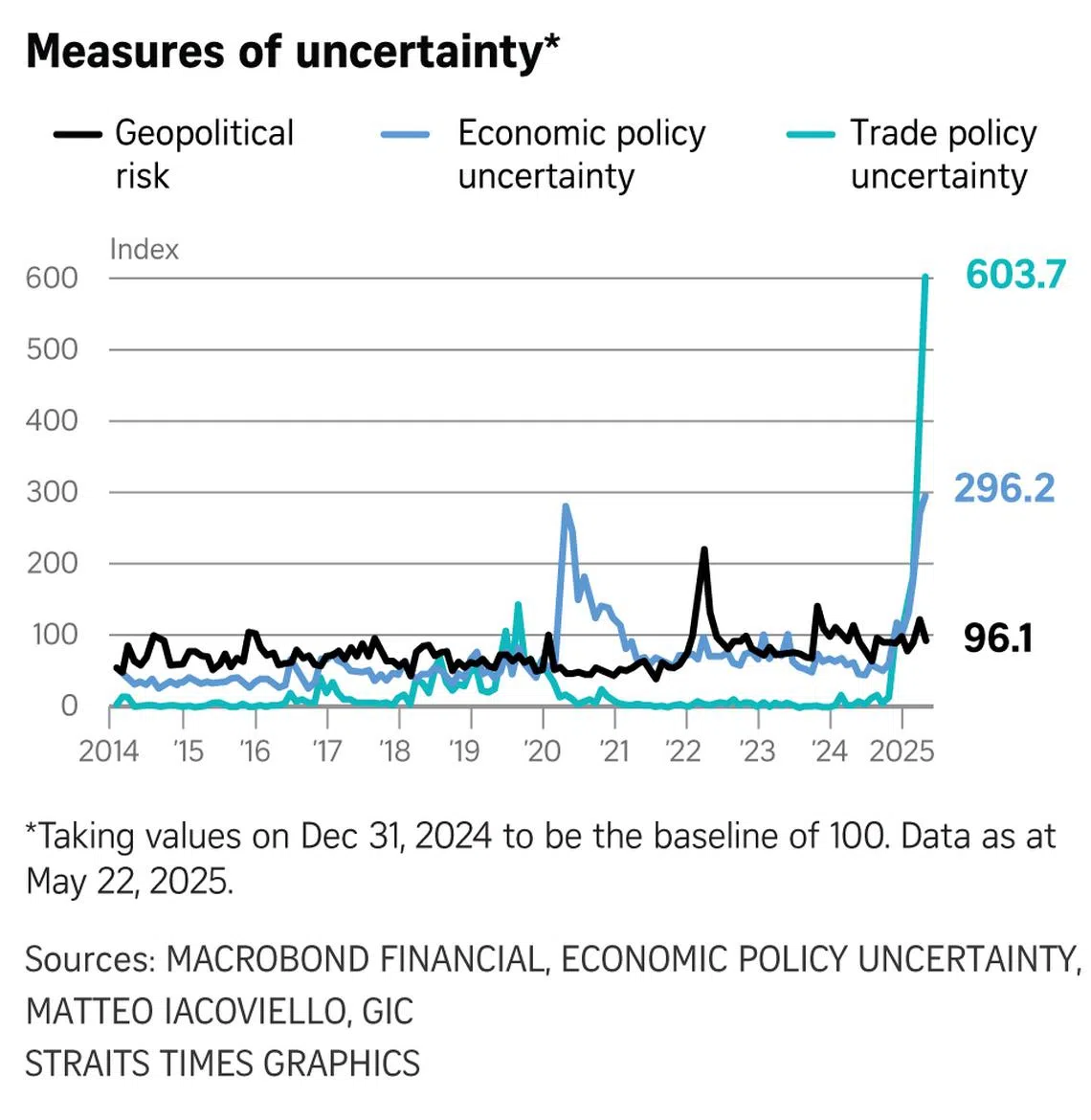GIC posts 3.8% annualised real return over 20 years despite economic uncertainties
Sign up now: Get ST's newsletters delivered to your inbox
![CMG20231214-HengYY01 / 王彦燕 /新加坡政府投资公司 GIC Private Limited [ 168 Robinson Rd, #37-01 ]
caption: GIC办公室 A signage of Singapore’s sovereign wealth fund GIC is pictured at their office in Singapore .](https://cassette.sphdigital.com.sg/image/straitstimes/918fb8a6b19c91fe2f21a55b5a64c7fd2073c4bb972bbb456ddeec80b99d7282)
The state investor recorded a real rate of return of 3.8 per cent a year for the 20 years to March 31, 2025.
PHOTO: LIANHE ZAOBAO
Follow topic:
SINGAPORE – The returns on GIC’s investment portfolio have remained stable despite trade uncertainties, geopolitical upheaval and volatile markets, according to its annual report on July 25.
The sovereign wealth fund recorded a real rate of return of 3.8 per cent a year for the 20 years to March 31, 2025, down 0.1 percentage point from results a year ago.
This figure, which is adjusted for inflation, is over and above the global inflation that has occurred throughout the same 20-year window.
Without adjusting for inflation, GIC’s annualised return came in at 5.7 per cent over the same 20-year period. This is expressed in US dollars.
The figures are calculated on a rolling basis, which means the real rate of return for the year ending March 31, 2005, will drop out of the calculation in 2026.
This 20-year annualised real rate is the main yardstick GIC uses, as these figures are said to better reflect the firm’s mandate to achieve long-term returns exceeding global inflation. It does not publish the rate of return of each single year.

GIC’s investments and asset mix also saw some changes over the last financial year.
Its portfolio exposure to the Americas – comprising North and Latin America – increased from 44 per cent to 49 per cent over the 12 months.

Chief executive Lim Chow Kiat told a briefing on July 24 that this increase was driven by the appreciation of existing holdings in the region and more capital deployment, especially to the US – GIC’s biggest investment destination.
Conversely, its exposure to the Asia-Pacific region declined from 28 per cent to 24 per cent over the year.
The firm does not allocate a fixed limit on investments in any country or region, Mr Lim said, noting: “Every region competes for our capital in a way that changes reflect where we have found more or less opportunities.”

The asset mix also changed, with the equities share of GIC’s portfolio rising from 46 per cent to 51 per cent over the year, while fixed income made up 26 per cent, down six percentage points.
Real assets accounted for 23 per cent, up slightly from 22 per cent.
Meanwhile, the volatility of GIC’s monthly returns clocked in at around 7 per cent over both the previous five and 10 fiscal years.
It noted that this medium-term consistency was delivered despite growing uncertainty in trade, geopolitics and global economies, which have in turn increased market volatility.
Mr Lim and GIC group chief investment officer Bryan Yeo said artificial intelligence development, climate change and a shifting world order are among what the firm deems “foundational” changes.
Such changes, they said, are to be distinguished from both cyclical shifts and “structural” changes such as in demographics for which long-term plans can be made.
Mr Lim said GIC aims to deliver long-term returns while avoiding “permanent loss” by leaning on diversification, being agile and what it calls granularity in its investment strategy.
Providing one example of this granularity, Mr Yeo said GIC classifies potential AI investments into three value-creating categories: enablers, monetisers and adopters.
Enablers are companies that build infrastructure to scale up AI usage, such as data centres, in which GIC started investing a decade ago.
Monetisers are firms that create and sell AI-infused products. “They tend to be more of the start-ups that have found a niche and are creating new products through AI capabilities,” Mr Yeo said.
Adopters are generally large, established companies across various sectors that are integrating AI into their processes.

“Granularity is about looking two, three layers deeper, and being deliberate about how we allocate and how we reinvest proceeds from divestments,” Mr Yeo said.
Mr Yeo did not rule out divesting holdings in established players that are at high risk of losing out to competitors in AI adoption.
He warned that it is too early to tell which sectors and companies specifically need divestment, but acknowledged that any success for monetisers and adopters will come at the expense of other companies.
AI is making its presence felt at GIC itself in the form of a chatbot being trialled in its real estate and fixed income teams to analyse investment reports to find gaps and highlight salient questions.
This shows how GIC is applying technology in the heart of its business, but with caution, Mr Lim said.
The energy sector
Though GIC finds attractive opportunities, especially in the electrification and energy efficiency segments, Mr Yeo said there are “fragmented investment trends across different regions”.
For instance, natural gas will continue to play a key role in the US over the medium term, but renewables remain well positioned in Europe, China and India.
Mr Lim responded to questions about GIC’s sustainability efforts by reiterating the firm’s goal to help the “real world” to transition.
“Rather than for us to almost artificially change our portfolio composition just to show less carbon intensity, we believe it is more important that our effort, not just in capital provision but also in our engagement with companies, would help the real-world transition.”
Mr Yeo added that GIC is set apart by its long-term approach, which allows investing in promising sustainable technologies and companies that it sees a significant need for, even if risk premiums are high at that point.
Mr Lim also turned to the weaker greenback, noting that while the US dollar accounts for a significant part of GIC’s currency exposure, the firm’s portfolio is diversified among many other dimensions besides currency to ensure it can beat global inflation.
Mr Yeo added: “If you look at US companies, many of them are large successful (multinational corporations) and... a good part of their revenue is actually derived overseas.
“So, if we were to have a scenario that the dollar is going to be weaker, their revenues and profits are actually going to go up because the foreign earnings from stronger currencies would translate to more US dollar revenue and earnings.”
The Straits Times also asked Mr Lim about concerns raised in Michigan about GIC’s ownership of 218,000ha of forested land, amounting to around 5 per cent of the total land area of the US state’s Upper Peninsula.
Mr Lim cited GIC’s longstanding policy to decline comment on specific investments, but added: “I would say GIC is welcome everywhere in terms of our investment, and on our part, we make sure all our investments are in compliance with laws and regulations, and that we adopt... practices that are consistent with (the) market.”


